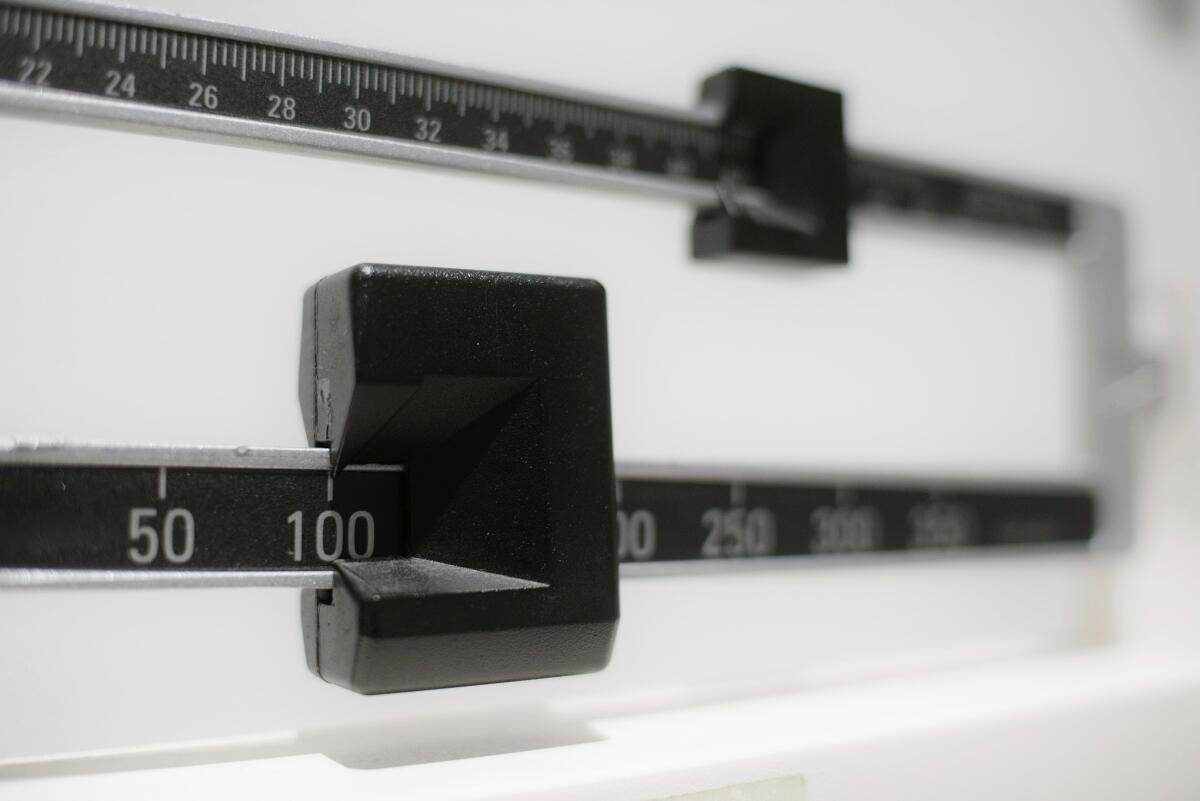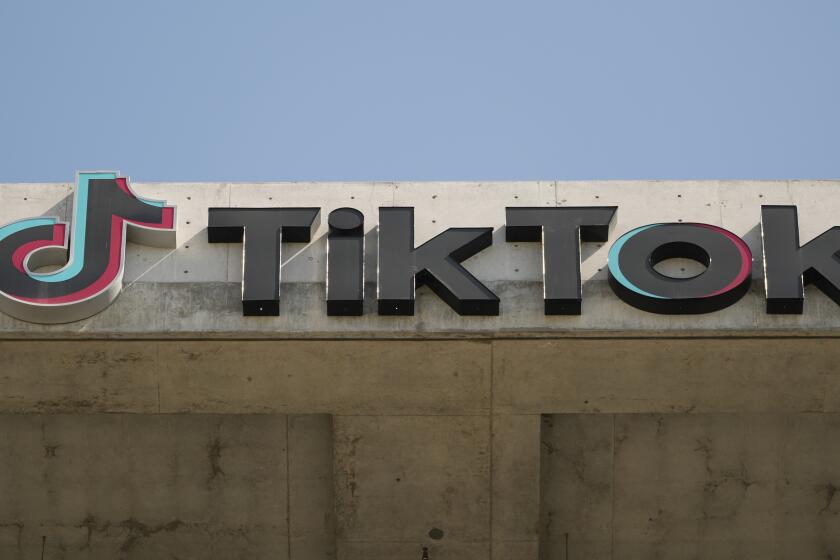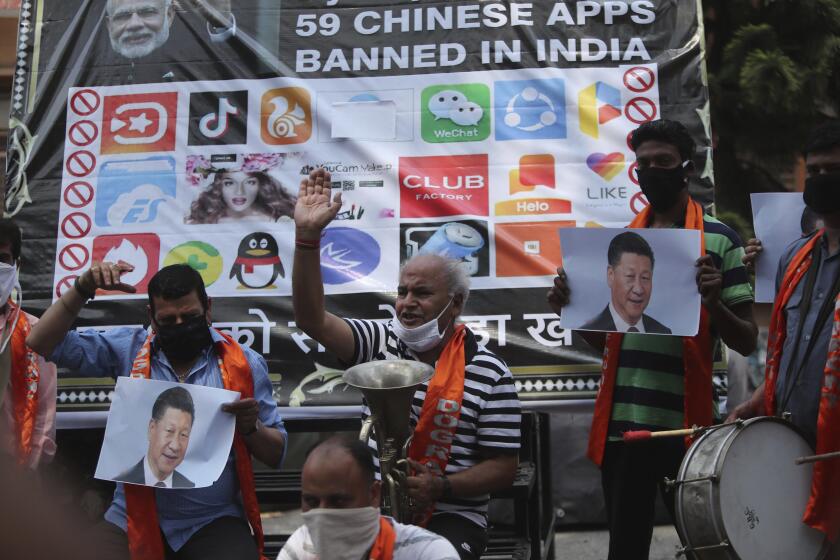TikTok to crack down on content that promotes disordered eating and dangerous weight-loss habits

- Share via
Saying it does not want to promote negative body comparisons, TikTok is cracking down on posts about disordered eating, dangerous weight loss habits and potentially harmful weight management products.
The wildly popular social media app updated its community guidelines last week, introducing a slate of rules that it hopes will make the platform a safer place for its roughly 1 billion users worldwide.
The initiative comes at a time when TikTok, which is owned by Beijing technology firm ByteDance, is facing increased scrutiny over its operations and content as it fights a potential ban in the U.S.
Weight loss videos make up a huge category on TikTok, with influencers extensively detailing and demonstrating how they slimmed down. Such videos have proliferated in the last few years with the rise of injectable prescription drugs such as Ozempic, Wegovy and Mounjaro, which many people are using to shed weight quickly.
Critics say the skyrocketing demand for the drugs has exposed the cracks in the body positivity movement, showing that there is still immense pressure to look thin at whatever cost. They say TikTok and Instagram, anti-aging filters, selfie culture and relentless celebrity and influencer self-promotion have all contributed to the problem.
Patients taking Ozempic and other trendy injectables are going under the knife to correct the side effects of rapid weight loss, which include sagging skin, hollow cheeks and an aged appearance.
TikTok already had policies around body image and disordered eating, but the updated guidelines explicitly break down such content into four categories: allowed; not allowed; restricted to users 18 and older; and ineligible for the “For You Feed,” TikTok’s personalized recommendation algorithm. They go into effect May 17.
The guidelines are intended to “improve understanding and bring greater transparency about our rules and how we enforce them,” Adam Presser, TikTok’s head of operations as well as the company’s trust and safety unit, said in a statement.
In the past, TikTok creators said they would sometimes see posts restricted or removed without understanding why they were flagged.
TikTok now clearly states that it bans videos “showing, describing, promoting, or offering or requesting coaching for disordered eating or dangerous weight-loss behaviors.”
The company defines those behaviors as extreme low-calorie diets, binging and intentional vomiting, misusing medication or supplements for weight loss and exercising through serious injuries or illness.
TikTok specifically called out content that shows or promotes unhealthy body measurements and “body checking” trends, such as comparing the size of body parts to household objects, as not allowed. Facilitating the trade or marketing of weight loss or muscle gain products is also on its way out.
Content that will be restricted to users 18 and older — and which will also be ineligible for the For You Feed — includes showing or promoting “potentially harmful weight-management behaviors” such as restrictive low-calorie diets; using medication or supplements for weight loss or muscle gain; and exercises designed for rapid and significant weight loss, such as “cardio routines that promise to help you lose a waist size in a week,” the company said.
TikTok also said it would restrict before-and-after transformation photos promoting weight loss and muscle gain products, as well as videos that promote body types as “ideal or perfect” when associated with potentially harmful weight management behaviors.
“We want TikTok to be a place that encourages self-esteem,” the company said.
Creators who have documented their weight loss journeys using the new class of trendy medications said they were disappointed by the crackdown. TikTok, they said, has become an important resource and close-knit community for people who have struggled for years to shed pounds and get healthy.
You’re just shutting down and secluding a group of people that is already so used to being shamed and put in a corner.
— Kelsey Martinez, 32, a content creator who has chronicled her weight-loss journey on TikTok
“I think countless amounts of lives have been saved by the ability to communicate about these medications,” said Kelsey Martinez, 32, who began posting about using Mounjaro, a medication intended to treat Type 2 diabetes, to lose weight in September 2022. She weighed 232 pounds when she started using the weekly injectable; by last fall, she was down to 153.
“It’s giving people who are obese access and that’s something we don’t always have,” said Martinez, who lives in Los Angeles and has 296,000 TikTok followers. “So I think it’s going to be very harmful. You’re just shutting down and secluding a group of people that is already so used to being shamed and put in a corner.”
Congress passed a bill that could ban TikTok. What could happen next, and who might buy the social media platform?
A spokesperson for TikTok said content about medically necessary health interventions under the guidance of a medical or health professional is allowed, including discussions about glucagon-like peptide 1 medications, which includes the diabetes drug Ozempic. The spokesperson added that content about using GLP-1 medications for weight loss could still be discovered in other ways, such as through search tools or by following an account, even if it is ineligible for the For You Feed.
Showing or describing competitive eating contests; fitness routines, sports and nutrition that are not primarily focused on extreme weight loss, marathon training or bodybuilding competitions; and religious diet behavior and fasting will still be allowed.
TikTok users will be permitted to condemn disordered eating, dangerous weight loss behaviors or potentially harmful weight management “as long as it does not show or describe a diet or behavior,” the company said.
Michelle York, a full-time content creator from Moorpark, said she understood that the app is in a “really tough spot” right now as it faces a divest-or-ban bill in the U.S., where it has 170 million users.
“TikTok is under a big microscope, and they need to go out of their way to make sure it’s a safe space,” York, 40, said. But “I think they’re overcompensating by making these new guidelines.”
In June 2020, TikTok users in India bid goodbye to the app, which is operated by Chinese internet firm ByteDance.
Even though she believes her content is beneficial and far from promoting “get-thin-quick supplements,” and despite her follower base of 203,000 people imploring her to keep the weight loss content coming, she has already turned some of her old Mounjaro videos private and will focus even more on lifestyle and beauty content going forward.
“It’s really disheartening to be told I can’t share that here anymore, and now it’s at risk of my platform, which I worked so hard to build,” York said. “The problem is, this is now my job — I rely on this as my income and I can’t post things to jeopardize that.”
TikTok’s latest community guidelines also include new and updated definitions on the company’s policies around hate speech and health misinformation.
In announcing the updated rules, TikTok said it would introduce a “warning strike” when a creator violates the platform’s community guidelines for the first time.
“The warning strike does not count toward an account’s strike tally, but any future violations will,” Presser said. “We notify creators about which rule they’ve broken and how they can appeal if they believe a mistake has been made. Zero-tolerance policies (for example, incitement to violence) aren’t eligible for these reminders; accounts will immediately be banned.”
More to Read
Inside the business of entertainment
The Wide Shot brings you news, analysis and insights on everything from streaming wars to production — and what it all means for the future.
You may occasionally receive promotional content from the Los Angeles Times.














